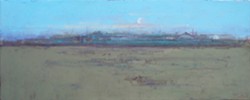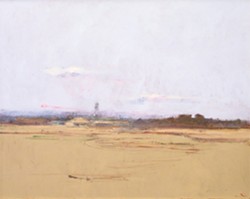
- ARTWORK BY TERRY DELAPP
- MOON, VALERO, AND 7-11 : Cambria artist Terry DeLapp has long painted the serene farmland of Central California, though a recent trip back to the places he once captured on canvas revealed the creeping imposition of industry. Now, cell phone towers and satellites dishes dot his agrarian scenes.
Cambria painter Terry DeLapp’s newest body of work is at once sorrowful and serene. DeLapp’s current exhibit, “Mundus Cerialis,” which hangs at the San Luis Obispo Museum of Art, is also deceptively simple, a series of repeated motifs rendered with the kind of ease afforded only by great skill. Over and over again, DeLapp depicts an enormous, fallow foreground of dirt, dust, or wildflowers. In the distance, where this huge swath of ground connects with an equally expansive stretch of blue sky, is a thin line of civilization just barely perceptible on the horizon. Take away these narrow strips of development—homes, farms, satellite dishes, and cell phone towers—and the works would resemble color field paintings. Pan out just a little, it seems, and the horizon would swallow it all.
DeLapp has long been depicting the landscapes of Central California, taken with the bucolic, utilitarian beauty of the agricultural communities found there. Upon returning to these places, however, the artist discovered that many of the farmhouses and barns he’d so enjoyed capturing were now gone, often replaced by imposing industrial structures. Though saddened, DeLapp continued to paint these scenes as they were, resulting in the bittersweet juxtapositions present throughout “Mundus Cerialis.” Farmhouses are charming yet dilapidated. Ominously painted cell phone towers overshadow quaint-looking water towers. DeLapp’s brushstrokes often deliberately obscure the structures on the horizon line. Perhaps this touch is meant to represent the way such scenes appear to someone driving by: blurred and barely memorable, everything kind of bleeding together. Perhaps the technique conveys the gradual yet persistent erasure of the traditional agrarian landscape DeLapp has come to love. Or perhaps tears of loss have simply clouded his view.

- ARTWORK BY TERRY DELAPP
- PIXLEY : DeLapp’s exhibit “Mundus Cerialis,” currently hanging at SLOMA, takes its name from a vault in the earth where ancient Romans once made offerings to deities of both agriculture and the underworld.
- BITTERSWEET IMPOSITIONS: “Mundus Cerialis” hangs at the San Luis Obispo Museum of Art, 1010 Broad St. downtown, through Dec. 3. The museum is open 11 a.m. to 5 p.m. every day but Tuesday. For more information, visit sloma.org or call 543-8562.
The show’s title may offer some insight into DeLapp’s thought process. Latin for “the world of Ceres,” a mundus cerialis in ancient Roman times was a underground pit or vault, shaped like an inverted dome, Throughout most of the year, the mundus cerialis was sealed, but it was opened on Aug. 24, Oct. 5, and Nov. 8. Following the official announcement “mundus patet”—the mundus is open—offerings could be made to agricultural and underground deities, including Ceres herself, the goddess of grain and agricultural prosperity and the guardian to the underworld. While it was open, the spirits of the dead could roam about in the land of the living, returning again when the mundus was sealed.
The concept of a mundus cerialis, and Ceres’ status as a deity of both agriculture and the underworld, seem to denote a certain comfort with the idea of the earth as the starting and ending point of all life, providing nourishment to the living and in turn receiving nourishment from the bodies of the dead. That DeLapp would name this particular exhibit after this sacred vault in the earth invites reflection, as the industrial ugliness that creeps into the picture in “Mundus Cerialis” would, contrary to its name, imply a diminishing connection to the natural world. The juxtaposition may remind us of what the human race has to lose when the earth is no longer considered sacred.
Arts Editor Anna Weltner keeps her eyes on the horizon. Contact her at [email protected].
Comments